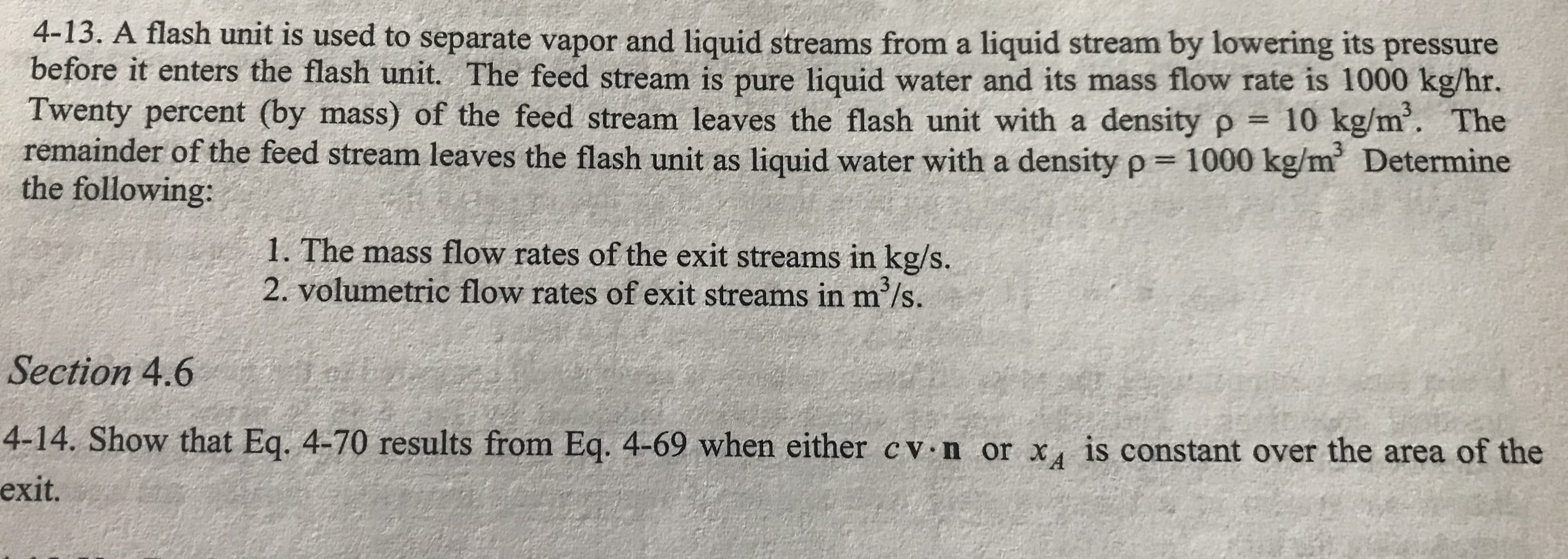4-13. A flash unit is used to separate vapor and liquid streams from a liquid stream by lowering its pressure before it enters the flash unit. The feed stream is pure liquid water and its mass flow rate is 1000 kg/hr. Twenty percent (by mass) of the feed stream leaves the flash unit with a density p 10 kg/m. The remainder of the feed stream leaves the flash unit as liquid water with a density p 1000 kg/m Determine the following: 3 1. The mass flow rates of the exit streams in kg/s. 2. volumetric flow rates of exit streams in m /s. Section 4.6 4-14. Show that Eq. 4-70 results from Eq. 4-69 when either c v n or x is constant over the area of the exit.
4-13. A flash unit is used to separate vapor and liquid streams from a liquid stream by lowering its pressure before it enters the flash unit. The feed stream is pure liquid water and its mass flow rate is 1000 kg/hr. Twenty percent (by mass) of the feed stream leaves the flash unit with a density p 10 kg/m. The remainder of the feed stream leaves the flash unit as liquid water with a density p 1000 kg/m Determine the following: 3 1. The mass flow rates of the exit streams in kg/s. 2. volumetric flow rates of exit streams in m /s. Section 4.6 4-14. Show that Eq. 4-70 results from Eq. 4-69 when either c v n or x is constant over the area of the exit.
Introduction to Chemical Engineering Thermodynamics
8th Edition
ISBN:9781259696527
Author:J.M. Smith Termodinamica en ingenieria quimica, Hendrick C Van Ness, Michael Abbott, Mark Swihart
Publisher:J.M. Smith Termodinamica en ingenieria quimica, Hendrick C Van Ness, Michael Abbott, Mark Swihart
Chapter1: Introduction
Section: Chapter Questions
Problem 1.1P
Related questions
Question
question 13
with a degree of freedom analysis along with a chart of the information given and needed

Transcribed Image Text:4-13. A flash unit is used to separate vapor and liquid streams from a liquid stream by lowering its pressure
before it enters the flash unit. The feed stream is pure liquid water and its mass flow rate is 1000 kg/hr.
Twenty percent (by mass) of the feed stream leaves the flash unit with a density p 10 kg/m. The
remainder of the feed stream leaves the flash unit as liquid water with a density p 1000 kg/m Determine
the following:
3
1. The mass flow rates of the exit streams in kg/s.
2. volumetric flow rates of exit streams in m /s.
Section 4.6
4-14. Show that Eq. 4-70 results from Eq. 4-69 when either c v n or x is constant over the area of the
exit.
Expert Solution
This question has been solved!
Explore an expertly crafted, step-by-step solution for a thorough understanding of key concepts.
This is a popular solution!
Trending now
This is a popular solution!
Step by step
Solved in 6 steps with 6 images

Knowledge Booster
Learn more about
Need a deep-dive on the concept behind this application? Look no further. Learn more about this topic, chemical-engineering and related others by exploring similar questions and additional content below.Recommended textbooks for you

Introduction to Chemical Engineering Thermodynami…
Chemical Engineering
ISBN:
9781259696527
Author:
J.M. Smith Termodinamica en ingenieria quimica, Hendrick C Van Ness, Michael Abbott, Mark Swihart
Publisher:
McGraw-Hill Education

Elementary Principles of Chemical Processes, Bind…
Chemical Engineering
ISBN:
9781118431221
Author:
Richard M. Felder, Ronald W. Rousseau, Lisa G. Bullard
Publisher:
WILEY

Elements of Chemical Reaction Engineering (5th Ed…
Chemical Engineering
ISBN:
9780133887518
Author:
H. Scott Fogler
Publisher:
Prentice Hall

Introduction to Chemical Engineering Thermodynami…
Chemical Engineering
ISBN:
9781259696527
Author:
J.M. Smith Termodinamica en ingenieria quimica, Hendrick C Van Ness, Michael Abbott, Mark Swihart
Publisher:
McGraw-Hill Education

Elementary Principles of Chemical Processes, Bind…
Chemical Engineering
ISBN:
9781118431221
Author:
Richard M. Felder, Ronald W. Rousseau, Lisa G. Bullard
Publisher:
WILEY

Elements of Chemical Reaction Engineering (5th Ed…
Chemical Engineering
ISBN:
9780133887518
Author:
H. Scott Fogler
Publisher:
Prentice Hall


Industrial Plastics: Theory and Applications
Chemical Engineering
ISBN:
9781285061238
Author:
Lokensgard, Erik
Publisher:
Delmar Cengage Learning

Unit Operations of Chemical Engineering
Chemical Engineering
ISBN:
9780072848236
Author:
Warren McCabe, Julian C. Smith, Peter Harriott
Publisher:
McGraw-Hill Companies, The